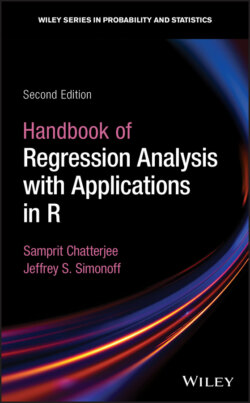Читать книгу Handbook of Regression Analysis With Applications in R - Samprit Chatterjee - Страница 22
1.3.3 HYPOTHESIS TESTS AND CONFIDENCE INTERVALS FOR β
ОглавлениеThere are two types of hypothesis tests of immediate interest related to the regression coefficients.
1 Do any of the predictors provide predictive power for the target variable? This is a test of the overall significance of the regression,versusThe test of these hypotheses is the ‐test,This is referenced against a null ‐distribution on degrees of freedom.
2 Given the other variables in the model, does a particular predictor provide additional predictive power? This corresponds to a test of the significance of an individual coefficient,versusThis is tested using a ‐test,which is compared to a ‐distribution on degrees of freedom. Other values of can be specified in the null hypothesis (say ), with the ‐statistic becoming(1.9) The values of are obtained as the square roots of the diagonal elements of , where is the residual mean square (1.8). Note that for simple regression (), the hypotheses corresponding to the overall significance of the model and the significance of the predictor are identical,versusGiven the equivalence of the sets of hypotheses, it is not surprising that the associated tests are also equivalent; in fact, , and the associated tail probabilities of the two tests are identical.A ‐test for the intercept also can be constructed as in (1.9), although this does not refer to a hypothesis about a predictor, but rather about whether the expected target is equal to a specified value if all of the predictors equal zero. As was noted in Section 1.3.1, this is often not physically meaningful (and therefore of little interest), because the condition that all predictors equal zero cannot occur, or does not come close to occurring in the observed data.
As is always the case, a confidence interval provides an alternative way of summarizing the degree of precision in the estimate of a regression parameter. A confidence interval for has the form
where is the appropriate critical value at two‐sided level for a ‐distribution on degrees of freedom.
